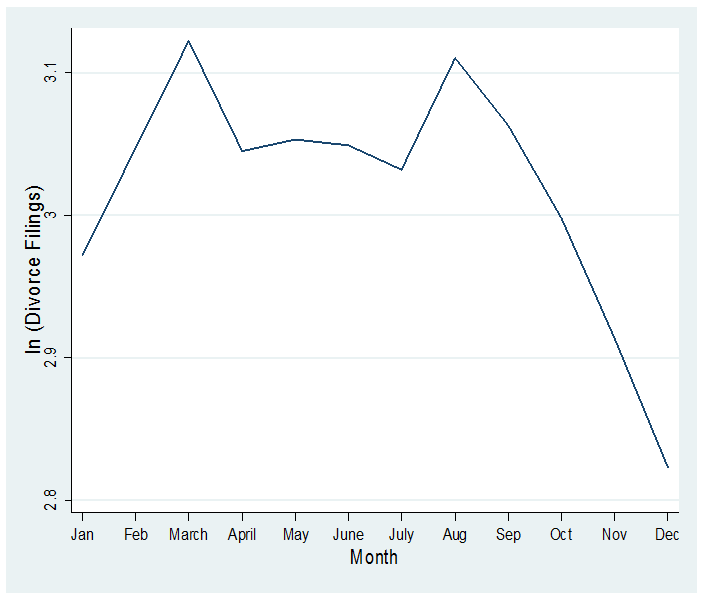
Massachusetts divorce lawyer Carmela Miraglia reacts to recent news stories proclaiming January as “Divorce Month”.
Last fall, I penned “Back to School Doesn’t Have to Mean Back to Court.” In that blog, I discussed how divorced and separated parents frequently choose (knowingly or not) September as a time to address their family law issues, which often leads to them finding themselves first in my office and then in court. So, you can imagine my surprise when I came across CNN’s recent article proclaiming that January is the #1 month for filing for divorce:
In recent years, January has earned the nickname “Divorce Month” — a less appealing title than National Pet Month (May) or National Honey Month (September), though divorce can surely be both hairy and sticky. …. While marital psychologists and divorce lawyers say January’s more accurate description would be “I’m Starting to Research My Options Month,” they might still agree that there is some accuracy in the nomenclature.
So, is January really divorce month? And if so, why? The data does seem to support the idea that divorce peaks after Christmas. CNN’s piece relies heavily on Findlaw’s research on divorce filings from 2008 to 2011, suggesting that divorce filings do indeed increase after the holidays, although the exact timing of this spike – and whether it occurs in January at all – remains a matter of debate.
Table of Contents for this Blog
- September vs. January: Which is the Real “Divorce Month”?
- Holiday Distraction: Divorces Increase in January because Spouses Ignore Marital Problems During the Holidays
- A Lawyer’s View: Similarities and Differences Between the Fall and Winter Peaks
- The Undisputed Divorce Dead Zone: Summer
- What About March? New Study Says March (not January) is the Real “Divorce Month”
- Peaks and Valleys in the Divorce Season: Is it the Weather, Habit or Culture?
September vs. January: Which is the Real “Divorce Month”?
As I noted in last fall’s blog, family law lawyers often see a spike in litigation in the fall, when parents see their schedules open up as children return to school and summer vacations come to a close:
The first day of school and the weeks leading up to that special day are often overwhelming, taxing already busy schedules and giving rise to new expenses. There are enrollment issues, parent-teacher meetings, sporting teams and extra-curricular activity sign-ups, the need for choosing and purchasing school supplies, choosing and purchasing new outfits, bus schedules, coordinating personal schedules, and so on. These added pressures often create feelings of regret, resentment and even anger.
Add to these feelings the simple fact that children enrolled in school do not require as much supervision, rides to camps, vacations or other attention. The fall represents a time of transition, so it’s not surprising that many parents also feel it is time to address any overdue probate and family court issues.
The “back to reality” feeling that hits people as summer changes to fall is deeply engrained in the American psyche. Arguably, we have been programmed from our earliest memories to treat the end of summer as a time to take stock, get serious, and address the problems we have been putting off. Indeed, CNN’s article acknowledges that most family law professionals regard September – and not January – as the true “Divorce Month”:
But all three experts referenced another unlikely month for the same phenomenon: September. …. Banschick says it’s because summertime is wedding and vacation season; the kids are home from school, and “it’s not a time to make troubles.” …. The shared root of their conclusion: This particular season of togetherness is over; now it’s back to real life.
However, CNN is not the only media outlet hyping January as “Divorce Month”. Marketwatch is also on the January bandwagon, boldly declaring January the peak divorce month in this somewhat thinly-sourced piece:
Divorce filings surge in January as people decide to start their New Year with a clean slate, helped by a stressful holiday period and, perhaps, even more stressful in-laws, experts say, with family lawyers reporting a rise of nearly one-third in business in the New Year.
So, what is the verdict? Does January challenge September as the real “Divorce Month”? The answer is: sort of. Divorce lawyers may not agree on much, but most of us acknowledge two main seasonal peaks in divorce consultations, filings and litigation: September and post-holidays, in that order. What we see starting in mid-January can be described as a less intense version of the September effect, with people deciding to “get serious” after the holidays, much the same way they do as summer ends. However, the September spike tends to be short and intense, while the post-holiday peak steadily percolates from January until the end of March.
Holiday Distraction: Divorces Increase in January because Spouses Ignore Marital Problems During the Holidays
Even if September is the real “Divorce Month”, it is worth discussing some of the specific issues that make the post-holiday period a close second in divorce activity. One theory for why divorce filings start to peak in a new year is that many spouses simply delay seeking a divorce during the holiday season because they are (a.) too busy with the holidays and (b.) doing their best to appear cheerful. A recent article by Wendi Schuller, author of the Global Guide to Divorce, cites the sheer busyness of the holiday season as a reason for spouses to delay confronting their marital problems until after Christmas:
A couple may be hoping that the holiday season will patch up any holes in their relationship. The magic of Christmas does not extend to fixing a broken marital partnership. …. The holidays can shine a spotlight on problems that are bubbling up just under the surface. Busy day to day activities with a packed schedule can mask issues that are not being addressed. When one or both have long job commutes or kids with jammed agendas, this enables a couple to pretend that everything is okay. …. Some spouses do not see that they are avoiding each other by participating in a whirlwind of holiday events.
Under Schuller’s theory, the January spike is simply a matter of delayed action: spouses put off a divorce to get through the holidays, which creates a glut of new filings in January. However, Schuller suggests there is more than just delayed action going on. She argues that the post-holiday blues many people experience are greatly magnified for spouses struggling with marital strife. Indeed, Schuller notes, the holidays often force spouses to spend more time together than usual. Time off from work, holiday travel, discussion about present-buying, family events and holiday parties all create potential friction points between spouses. For struggling spouses, a difficult holiday season can lead to a moment of clarity in the new year:
When holidays are lonelier being married than they ever were when single, this is a warning that something needs to be done. Holidays can be the big wakeup call that you really do not want to be with your partner for the next set of holidays the following December.
A Lawyer’s View: Similarities and Differences Between the Fall and Winter Peaks
In my experience, there are two big differences between the September and post-holiday divorce peaks. The first is the length of each peak. Each fall, we tend to see an intense spike in divorce over a roughly 6-week period, from late-August to mid-October, when Halloween decorations start going up. The post-holiday peak, on the other hand, tends to be longer, lasting about 15 weeks, from January through the end of March.
The second difference between the September and post-holiday peaks seems to be intensity. In September, clients tend to be filled with a sense of urgency and purpose to address their divorce and family law issues. These clients are often confident and assertive that they are ready to face their marital problems. However, wintertime divorce clients tend to be somewhat more subdued. Many clients seem to need a few weeks to recover from the bustling holidays before taking steps to address their divorce over the long, cold winter season.
In short, wintertime clients are not as optimistic about solving their problems, but seem to recognize that the winter is probably a good time to “pull off the band aid” or, in the natural tradition of celebrating a New Year, resolve for a “fresh start.” (Perhaps January clients simply have a hangover we all feel after the holiday season, rife with in-laws, expenses, those extra pounds we’ve all packed on, and the same 7 songs over–and–over–and–over–and–over.) Indeed, a fair number of litigants seem to spend the coldest winter months hunkering down and planning, only to file for divorce in March, at the very first signs of spring.
The Undisputed Divorce Dead Zone: Summer
Clearly, many people delay addressing their marital problems during the holiday season, from mid-November through the New Year. However, I should give a shout out to the real family law dead zone: summer. Even if divorcing or separated spouses hit “pause” for December, the holiday season only really lasts about six weeks. The realdead zone for divorce is from May to early August.
Few will shed a tear for the plight of the world’s divorce lawyers (lawyers need love, too), but the summer is a time when our phones stop ringing, consultations dwindle, and frustrated spouses forget their problems in a summertime blur of BBQs, sunshine, kids-home-from-school, and vacation travel. Summer represents a much-needed break from the stresses and problems of the real world.
What About March? New Study Says March (not January) is the Real “Divorce Month”
What if neither January nor September are the true “Divorce Month”? A recent University of Washington study suggests that divorce filings actually peak in March and August:
Associate sociology professor Julie Brines and doctoral candidate Brian Serafini found what is believed to be the first quantitative evidence of a seasonal, biannual pattern of filings for divorce. The researchers analyzed filings in Washington state between 2001 and 2015 and found that they consistently peaked in March and August, the periods following winter and summer holidays.
The study’s findings relating to August divorce filings essentially match the conventional wisdom about September; i.e. divorce filings peak when summer vacation ends. (This timing might also be affected by differences between public school schedules in Washington and other states.) The study’s findings on a March peak are more surprising, however. Researchers addressed the question directly:
[W]hat explains the spike in March, several months after the winter holidays?Couples need time to get finances in order, find an attorney or simply summon the courage to file for divorce, Brines suggests. Though the same considerations apply in summer, Brines thinks the start of the school year school may hasten the timing, at least for couples with children. Suicides also tend to peak in spring, and some experts have said the longer days and increased activity elevates mood enough to motivate people to act. Brines wonders if similar forces are at play with divorce filings.
Personally, I have always considered March divorce filings as the back end of the post-holiday surge. However, the study’s findings suggest that January may only seem like “Divorce Month” because of the extraordinary decrease in divorce filings in December. As the graph below shows, March might be the peak for divorce filings, but the month-to-month jump from December to January probably represents the biggest jolt of the year:

According to this University of Washington study, divorce filings peaked consistently in March and August over a 14-year period.
Peaks and Valleys in the Divorce Season: Is it the Weather, Habit or Culture?
As a Massachusetts divorce lawyer, my observations may differ from an attorney in a state like California, where seasonal weather plays a smaller role in driving people’s behavior. I doubt weather is the main the factor in divorce fluctuations, however. (Here seems like a good place to remind readers that Massachusetts has the seventh lowest divorce rate in the country, despite our awful weather, traffic andaccents.) Anyone who grew up in the United States experienced summer and Christmas vacations when they were children. The rhythms and routines we learn as children shape our behavior as adults, long after we have taken our last class or stopped believing in Santa. Indeed, parents often see these rhythms reinforced as they find their lives dictated by their children’s school schedules.
Arguably, Americans have culturally programmed themselves to avoid sticky problems during the summer and holidays seasons, leaving September and January as the months to “get serious” about tackling big problems. The University of Washington study reflects this reality, suggesting that summer and holiday lulls in divorce filings arise out of deep cultural norms:
Winter and summer holidays are culturally sacred times for families, Brines said, when filing for divorce is considered inappropriate, even taboo. And troubled couples may see the holidays as a time to mend relationships and start anew: We’ll have a happy Christmas together as a family or take the kids for a nice camping trip, the thinking goes, and things will be better.
For all the media hype about January being “Divorce Month”, the coverage reflects an underlying reality. For many, the new year is an opportunity to fix problems and make changes. In this sense, divorce is simply part of the larger pattern.
As a final thought, I will note that in addition to (allegedly) being “Divorce Month”, January is also National Blood Donor Month. In other words: no matter how you look at it, you’re bound to hear: this might hurt a little.
About the Author: Carmela M. Miraglia is a Massachusetts divorce lawyer and Cape Cod family law attorney for Lynch & Owens, located in Hingham, Massachusetts and East Sandwich, Massachusetts. She is also a mediator for South Shore Divorce Mediation.
Schedule a consultation with Carmela M. Miraglia today at (781) 253-2049 or send her an email.


